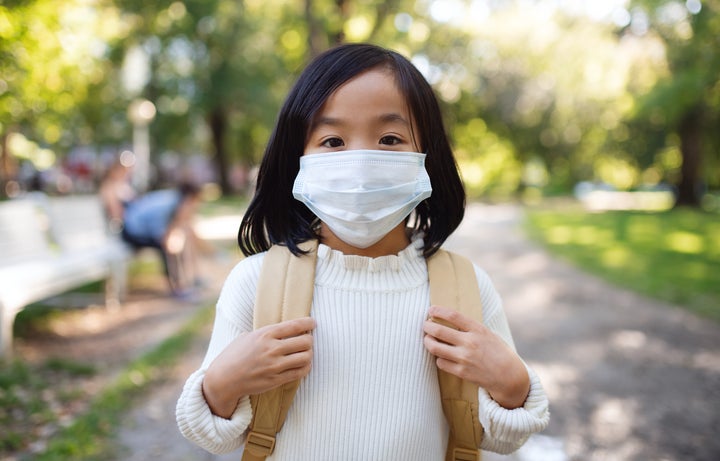
For more than a year now, American parents have done our best to evaluate the risks for our children amid COVID-19. We’ve tried to assess the benefits of certain activities, fretted about the risks and made best guesses — crossing our fingers that we were doing the right thing. Accordingly, families’ approaches to the past year have been wildly different. Some of us have been doing school and playdates for months; others are just starting to emerge from our homes.
Now we’re at yet another befuddling moment in pandemic parenting as the Centers for Disease Control and Prevention (CDC) once again shifted its guidelines about mask wearing for fully vaccinated people — without offering any specific guidance about kids. So while many Americans are celebrating the change, parents with younger kids are trying, yet again, to figure out what this means for their families.
“Speaking as a mother and pediatrician, I am tired of interpreting this data without clear guidance,” Dr. Mona Amin, a Florida-based pediatrician, recently posted on Instagram. “It has increased anxiety for parents who WANT to begin doing things, but are unsure how to navigate this with unvaccinated kids. With every decision that makes us adults celebrate we are left thinking, ‘Great, but what about our kids?’”
To be fair, though the new CDC mask recommendations don’t specifically talk about children, the group does emphasize that anyone who is age 2 and up, and who is unvaccinated — i.e., every child under the age of 12 — should continue to wear a mask indoors. And pediatricians tend to agree.
“Until younger children are eligible to be vaccinated for the coronavirus vaccine, they should continue to wear face masks when they are in public and around other people,” Dr. Yvonne Maldonado, chair of the American Academy of Pediatrics (AAP) committee on infectious diseases, told The Washington Post.
“Even adults and older children who are vaccinated may want to think about wearing masks if there are younger children in the family — either in solidarity or to keep the risk to unvaccinated children as low as possible,” The Washington Post noted.
But children under 12 are unlikely to be eligible for vaccination until this fall — or beyond. Which means vaccinated parents will be in a strange kind of mask limbo: technically free to go without one (unless their state or local recommendations state otherwise), but feeling generally unsure or even guilty about doing so.
Ultimately, of course, mask-wearing is not a major burden, and most of us have become really adept at doing it. But changing the guidelines without addressing the specific circumstances parents of young children now face — and are likely to for many more months — just adds another layer of confusion for moms, dads and other caregivers to muddle through.
And adults going mask-free could change children’s willingness to continue masking up all the time themselves. Kids take their cues from parents and the other trusted adults in their lives. If they see more and more of them going mask-free in public, it does confuse the messaging about why they have to continue to wear one, and why masks are so important — particularly for younger kids for whom masks have been kind of a tough sell. In my family, we’ve been trying for a full year to get my nearly 3-year-old to consistently wear a mask in public. He maxes out at about 45 minutes, at which point he invariably starts tugging it below his nose.
“With every decision that makes us adults celebrate we are left thinking, ‘Great, but what about our kids?'"”
- Dr. Mona Amin
There is another important layer to all of this for parents of younger children. As adults take their masks off in public, it will be impossible in many settings to know who is doing so because they’re fully vaccinated (and therefore poses less of a transmission risk), and who is doing so simply because they just don’t want to wear a mask anymore.
For children who aren’t able to get immunized yet themselves, that poses a real, direct risk. At least when public masking rules were uniform, it was a blanket way of making sure we were collectively doing what we can to keep our unvaccinated kiddos safe. Heck, even fully vaccinated people pose a small risk to children, because while it’s highly unlikely they can pass the virus on, it’s not impossible.
As Dr. Mona Amin recently posted on Instagram: “Vaccinated individuals can go maskless in public. This is great for vaccinated individuals. But what about establishments that remove mask requirements for all patrons without checking vaccination? What about parents who have to take their unvaccinated kids with them to the grocery store?”
And that’s all particularly true for parents of children who are immunocompromised, who have already lived through an exhausting and frightening year — and may now find it even harder to take their children into public spaces at all.
So ultimately, the new rules change nothing for younger children or their parents (once again!), and kids could actually be more vulnerable now than they were before. No wonder parents aren’t celebrating just yet.
Experts are still learning about COVID-19. The information in this story is what was known or available as of publication, but guidance can change as scientists discover more about the virus. Please check the Centers for Disease Control and Prevention for the most updated recommendations.